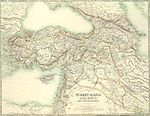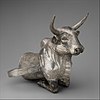Anatolian peoples
| Part of a series on |
| Indo-European topics |
|---|
 |
| History of Turkey |
|---|
 |
| Timeline |
|
|
The Anatolians were a group of distinct Indo-European peoples who spoke the Anatolian languages and shared a common culture.[1][2][3][4][5] The Anatolian languages were a branch of the larger family of Indo-European languages. According to the most widely accepted Kurgan theory on the Proto-Indo-European homeland, however, these Indo-European Anatolians were themselves immigrants to Anatolia from the north.
History
The archaeological discovery and eventual deciphering of the Hittites' written (cuneiform) archives, establishing the fact that the Hittite language belonged to a separate Anatolian branch of the Indo-European language family, caused a sensation among historians and forced a re-evaluation of Near Eastern history and Indo-European linguistics.[5] In accordance with the Kurgan hypothesis, J. P. Mallory notes in Encyclopedia of Indo-European Culture that it is likely that the Anatolians reached the Near East from the north, via the Balkans or the Caucasus, in the 3rd millennium BC.[5] Together with the proto-Tocharians, who migrated eastward, the Anatolians constituted the first known waves of Indo-European emigrants out of the Eurasian steppe.[6] Although they had wagons, they probably emigrated before Indo-Europeans had learned to use chariots for war.[6] It is likely that their arrival was one of gradual settlement and not as an invading army.[1] The Anatolians' earliest linguistic and historical attestation are as names mentioned in Assyrian mercantile texts from 19th Century BC Kanesh.[1]
The Hittites, who established an extensive empire in the Middle East in the 2nd millennium BC, are by far the best known members of the Anatolian group. Following the Bronze Age collapse, the lands of the Anatolian peoples were invaded with great frequency by a number of peoples and empires: the Phrygians, Bithynians, the Medes, the Persians, the Greeks, the Galatian Celts, and the Romans. Many of the invaders settled in Anatolia, sometimes causing the extinction of the Anatolian languages. By the Middle Ages, all Anatolian languages (and the cultures accompanying them) were extinct, but there may be lingering influences on the modern inhabitants of Anatolia, most notably Armenians.
List of Anatolian peoples
- Carians
- Hattians
- Hittites
- Isaurians
- Luwians
- Lycaonians
- Lycians
- Lydians
- Mysians
- Palaics
- Pamphylians
- Pisidians
- Sidians
See also
- Anatolianism
- Mitanni
- Kassites
- Purushanda
- Hyksos
- Sea peoples
- Qiang
- Philistines
- Maryannu
- Indo-Aryan superstrate in Mitanni
- Kikkuli
References
- ^ a b c Beckwith 2009, p. 37
- ^ Fortson, IV 2011, p. 48
- ^ Fortson, IV 2011, p. 170
- ^ Hock & Joseph 1996, pp. 520–521
- ^ a b c Mallory 1997, pp. 12–16
- ^ a b Beckwith 2009, p. 32
Sources
- Beckwith, Christopher I. (2009). Empires of the Silk Road: A History of Central Eurasia from the Bronze Age to the Present. Princeton University Press. ISBN 1-4008-2994-1. Retrieved 30 October 2012.
{{cite book}}: Invalid|ref=harv(help) - Fortson, IV, Benjamin W. (2011). Indo-European Language and Culture: An Introduction. John Wiley & Sons. ISBN 1-4443-5968-1. Retrieved 30 October 2012.
{{cite book}}: Invalid|ref=harv(help) - Hock, Hans Heinrich; Joseph, Brian Daniel (1996). Language History, Language Change, and Language Relationship: An Introduction to Historical and Comparative Linguistics. Walter de Gruyter. ISBN 3-1101-4784-X. Retrieved 30 October 2012.
{{cite book}}: Invalid|ref=harv(help) - Mallory, J. P. (1997). Encyclopedia of Indo-European Culture. Douglas Q. Adams. ISBN 1884964982. Retrieved 23 March 2013.
{{cite book}}: Invalid|ref=harv(help) - Melchert, H. Craig (2012). "The Position of Anatolian" (PDF).
{{cite web}}: Invalid|ref=harv(help) - Sharon R. Steadman; Gregory McMahon (15 September 2011). The Oxford Handbook of Ancient Anatolia: (10,000–323 BCE). Oxford University Press. ISBN 978-0-19-537614-2. Retrieved 23 March 2013.
{{cite book}}: Invalid|ref=harv(help)

